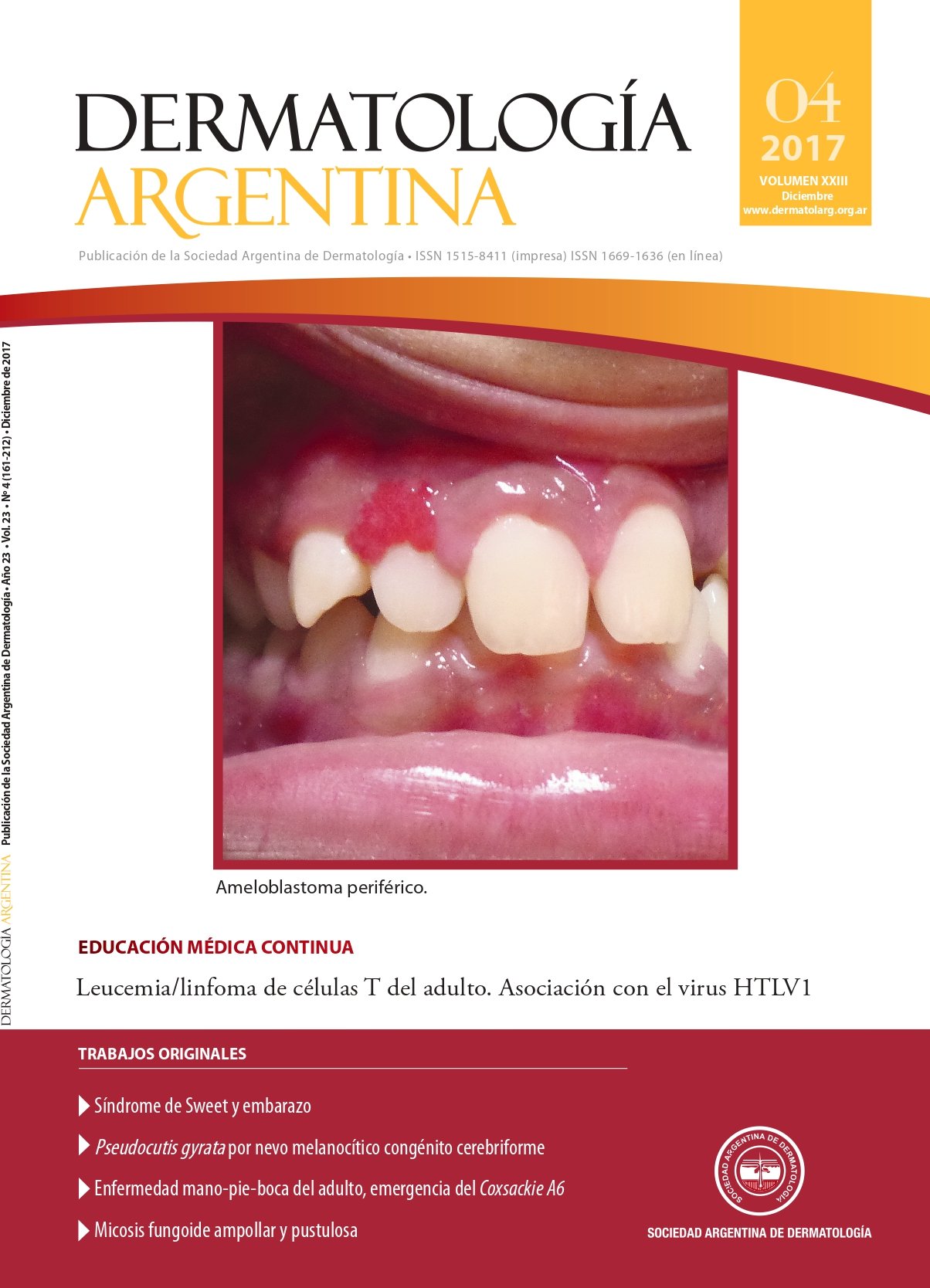Pseudocutis gyrata due to congenital cerebriform melanocytic nevus
Keywords:
pseudocutis gyrata, congenital melanocytic nevusAbstract
Cutis gyrata is a skin thickening with folds that cannot be stretched out, characterized by ridges and furrows resembling the surface of the brain. In general it occurs in the scalp at the level of the vertex, it gets the name cutis verticis gyrata. It can occur as individual disease or be a manifestation of different etiologies. It is usually classify into primary and secondary. The primary can be solitary or present other anomalies (syndromic).Pseudocutis verticis gyrata is cause by the infiltration of cellular elements that are foreign to the connective tissue.We present two cases of pseudocutis gyrata due to congenital melanocytic nevus, one solitary and the other associated to blue nevus and skin nevomatosis. We propose a new classification for cutis gyrata based on its etiopathogenesis.
References
I. Alcántara González J, Truchuelo Diez MT, Cerrillo Gijón R, Mar-tín Díaz RM, et ál. Cerebriform intradermal nevus presen-ting as secundary cutis verticis gyrata. Dermatology Online J 2010;16:14.
II. Al-Bedaia M, Al-Khenaizan AS. Acromegaly presenting as cutis verticis gyrate. Int J Dermatol 2008;47:164.
III. Lasser AE. Cerebriform intradermal nevus. Pediatr Dermatol1983;1:42-44.
IV. Cabrera HN, Cuda G, Costa JA. Cutis verticis gyrata por neuro-fibroma. Rev Argent Dermatol 1982;4:253-258.
V. Larsen F, Birchall N. Cutis verticis gyrata: three cases with di-fferent etiologies that demostrate the classification system. Australas J Dermatol 2007;48:91-94.
VI. Van Geest AJ, Berretty PJ, Klinkhamer PJ, Neumann HA. Cerebri-form intradermal naevus (a rare form of secondary cutis verticis gyrata). J Eur Acad Dermatol Venereol 2002;16:529-531.
VII. Pai VG, Rao GS. Congenital cerebriforme melanocytic naevus with cutis verticis gyrata. Indian J Dermatol Venereol Leprol2002;68:367-368.
VIII. Ramos-e-Silva M, Martins G, Dadalti P, Maceira J. Cutis verti-cis gyrata secondary to a cerebriform intradermal nevus. Cutis2004;73:254-256.
IX. Phiske M. Cerebriform intradermal nevus: a rare entity and its associations. Indian Dermatol Online J 2014;5:115-116.
X. Magnin PH, Schroh RG, Cajas R, Pacheco E, et ál. Particularida-des del nevo melanocítico cerebriforme. Rev Argent Dermatol 1987;68:341-347.
XI. Yazici AC, Ikizoglu G, Baz K, Polat A, et ál. Cerebriform intrader-mal nevus. Pediatr Dermatol 2007;24:141-143.
XII. Quaedvlieg PJ, Frank J, Vermeulen AH. Toonstra J, et ál. Giant cerebriform intradermal nevus on the back of a newborn. Pediatr Dermatol 2008;25:43-46.
XIII. Tagore KR, Ramineni AS. A case of cutis verticis gyrata secon-dary to giant cerebriform intradermal nevus. Indian J Pathol Microbiol 2011;54:624-625.
XIV. Hayashi Y, Tanioka M, Taki R, Sawabe K, et ál. Malignant mela-noma derived from cerebriform intradermal naevus. Clin Exp Dermatol 2009;34:e840-842.
XV. Sarkar S, Roychoudhury S, Shrimal A, Das K. Cerebriform intra-dermal nevus presenting as cutis verticis gyrata with multiple cellular blue nevus over the body: A rare occurrence. Indian Dermatol Online J 2014;5:34-37.
XVI. Rao AG, Koppada D, Haritha M. Giant cerebriform congenital cellular blue nevus presenting as cutis verticis gyrata. Indian J Dermatol 2016;61:126
Downloads
Published
Issue
Section
License
Copyright (c) 2017 Argentine Society of Dermatology

This work is licensed under a Creative Commons Attribution-NonCommercial-NoDerivatives 4.0 International License.
El/los autor/es tranfieren todos los derechos de autor del manuscrito arriba mencionado a Dermatología Argentina en el caso de que el trabajo sea publicado. El/los autor/es declaran que el artículo es original, que no infringe ningún derecho de propiedad intelectual u otros derechos de terceros, que no se encuentra bajo consideración de otra revista y que no ha sido previamente publicado.
Le solicitamos haga click aquí para imprimir, firmar y enviar por correo postal la transferencia de los derechos de autor













